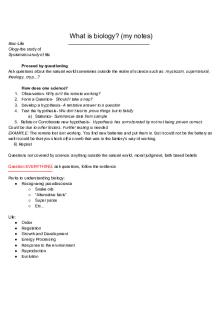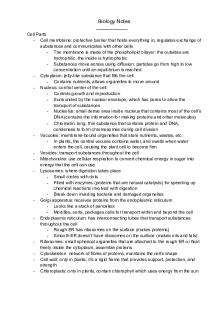Respiration - A-Level Biology notes PDF

| Title | Respiration - A-Level Biology notes |
|---|---|
| Course | Biology - A2 |
| Institution | Sixth Form (UK) |
| Pages | 3 |
| File Size | 184.4 KB |
| File Type | |
| Total Downloads | 17 |
| Total Views | 154 |
Summary
A-Level Biology notes...
Description
Chapter 12: Respiration
12.1 Glycolysis - Aerobic respiration requires O2 to produce CO2, H2O and ATP - Anaerobic respiration takes place in the absence of O2 and produces lactate and little ATP Aerobic respiration happens in 4 stages: 1. Glycolysis 2. Link reaction 3. Krebs cycle 4. Oxidative phosphorylation Process of glycolysis: 1. Glucose is phosphorylated which makes it more reactive. The phosphate come from hydrolysis of 2 ATP molecules. It provides the energy to activate glucose and lowers the activation energy for the enzyme controlled reaction. 2. Each glucose molecule splits into two 3 carbon TP molecules 3. Hydrogen is removed from both TPs and passed to a hydrogen carrier molecule NAD to form NADH 4. Each TP converts to pyruvate and two ATP molecules are generated
Overall yield (1 glucose molecules): - 4 ATP - 2 NADH - 2 pyruvate
12.2 Link reaction and Krebs Cycle Significance of Krebs cycle: - Hydrolyses macromolecules - Provide energy for oxidative phosphorylation, which leads to production of ATP - Regenerates the 4 carbon that combines with acetyl CoA, which would otherwise accumulate - It’s a source of intermediate compounds used by cells to make fatty acids, amino acids and chlorophyll Coenzymes: - NAD, FAD, NADP - Act as carriers of hydrogen atoms from one molecule to the other Link reaction
(Hans) Krebs cycles
Chapter 12: Respiration
1. Pyruvate is actively transported into the matrix of mitochondria 2. Pyruvate is oxidised to acetate. I roommate loses CO2 and 2H. NAD accepts these hydrogens to form NADH 3. 2 carbon acetate combines with coenzyme A (CoA) to produce acetyl CoA Overall yield (1 pyruvate molecule): - 1 Acetylcoenzyme A - 1 NADH - 1 CO2
1. Acetal CoA combines with a 2 carbon to produce a 6 carbon molecule 2. The 6 carbon molecule loses two CO2s to form a 4 carbon and an ATP molecule by substrate-level phosphorylation 3. The 4 carbon combines with a new molecule of acetyl CoA to restart the cycle Overall yield: - 3 molecules of NADH - 1 FADH2 - 2 CO2 - 1 ATP
12.3 Oxidative phosphorylation: in the mitochondria (in eukaryotic cells) Electron transfer chain: 1. Hydrogen atoms produced during glycolysis and the Krebs cycle with NAD and FAD 2. NADH and FADH2 donate their electrons which pass along the chain through a series of oxidation-reduction reactions. The energy released causes the active transport of protons across the inner mitochondrial membrane into the intermembranal space. 3. Protons accumulate in the inter-membranal space before diffusing back into the matrix through the ATP synthase channel. 4. At the end of the chain electrons combine with these protons and oxygen to form water. Oxygen is therefore the final acceptor of electrons.
Alternative respiratory substances: 1. Lipids: they’re hydrolysed from glycerol to fatty acids. Glycerol is then phosphorylated and converted to TP, which then begins the glycolysis cycle. At the end, oxidation of lipids produces 2 carbon fragments of carbohydrates and many hydrogen atoms (lipids release twice as much energy as carbohydrates) 2. Proteins: another source of energy are proteins, which get hydrolysed into amino acids. Then the amino acids groups are removed by deamination before entering the respiratory cycle at different points depending on how many carbons they hold.
Releasing energy in stages because when a lot of energy is released at once, most of it is lost to heat instead of being beneficial for the organism. This is why NADH and FADH2 aren’t transferred in one step. 12.4 Anaerobic respiration In the absence of oxygen, all FAD and NAD will be reduced thus they won’t be able to take up hydrogen atoms produced during the Krebs cycle and enzymes will therefore stop working. In eukaryotic cells, only two types of anaerobic respiration occurs: 1. Plants: yeast where pyruvate is converted to ethanol and carbon dioxide - Pyruvate + NADH = ethanol + carbon dioxide + NAD - This occurs in bacteria and fungi and plants - Pyruvate loses a carbon dioxide molecule and accepts a hydrogen atom from NADH to produce ethanol - Yeast is grown under anaerobic conditions in which it ferments grapes (wine) or barley seeds (beer) into ethanol
Chapter 12: Respiration 2. Animals: where pyruvate is converted to lactate (an acid). - Pyruvate + NADH = lactate + NAD - Lactate production occurs most commonly in muscles as a result of strenuous exercise. In this case oxygen is used up more rapidly than it’s supplied. - Once oxygen is available again, lactate is oxidised to make pyruvate. - Lactate causes pH to change which affects enzymes Energy from cellular respiration is derived in 2 ways: 1. Substrate-level phosphorylation in glycolysis and Krebs. It’s a direct transfer of phosphate from ADP to ATP. 2. Oxidative phosphorylation in the electron transfer chain In aerobic respiration, pyruvate isn’t available for the Krebs cycle to go on. Glycolysis is the only way that ATP can be made....
Similar Free PDFs

Essay questions Biology Alevel 9700
- 16 Pages

Cellular Respiration Notes
- 2 Pages

Cell respiration notes KEY
- 4 Pages

Biology Notes
- 7 Pages

Biology Notes
- 16 Pages

Biology class notes
- 18 Pages

SNC2D Biology booklet - Notes
- 53 Pages

Merged Marine Biology Notes
- 53 Pages

Developmental Biology Notes
- 16 Pages
Popular Institutions
- Tinajero National High School - Annex
- Politeknik Caltex Riau
- Yokohama City University
- SGT University
- University of Al-Qadisiyah
- Divine Word College of Vigan
- Techniek College Rotterdam
- Universidade de Santiago
- Universiti Teknologi MARA Cawangan Johor Kampus Pasir Gudang
- Poltekkes Kemenkes Yogyakarta
- Baguio City National High School
- Colegio san marcos
- preparatoria uno
- Centro de Bachillerato Tecnológico Industrial y de Servicios No. 107
- Dalian Maritime University
- Quang Trung Secondary School
- Colegio Tecnológico en Informática
- Corporación Regional de Educación Superior
- Grupo CEDVA
- Dar Al Uloom University
- Centro de Estudios Preuniversitarios de la Universidad Nacional de Ingeniería
- 上智大学
- Aakash International School, Nuna Majara
- San Felipe Neri Catholic School
- Kang Chiao International School - New Taipei City
- Misamis Occidental National High School
- Institución Educativa Escuela Normal Juan Ladrilleros
- Kolehiyo ng Pantukan
- Batanes State College
- Instituto Continental
- Sekolah Menengah Kejuruan Kesehatan Kaltara (Tarakan)
- Colegio de La Inmaculada Concepcion - Cebu






